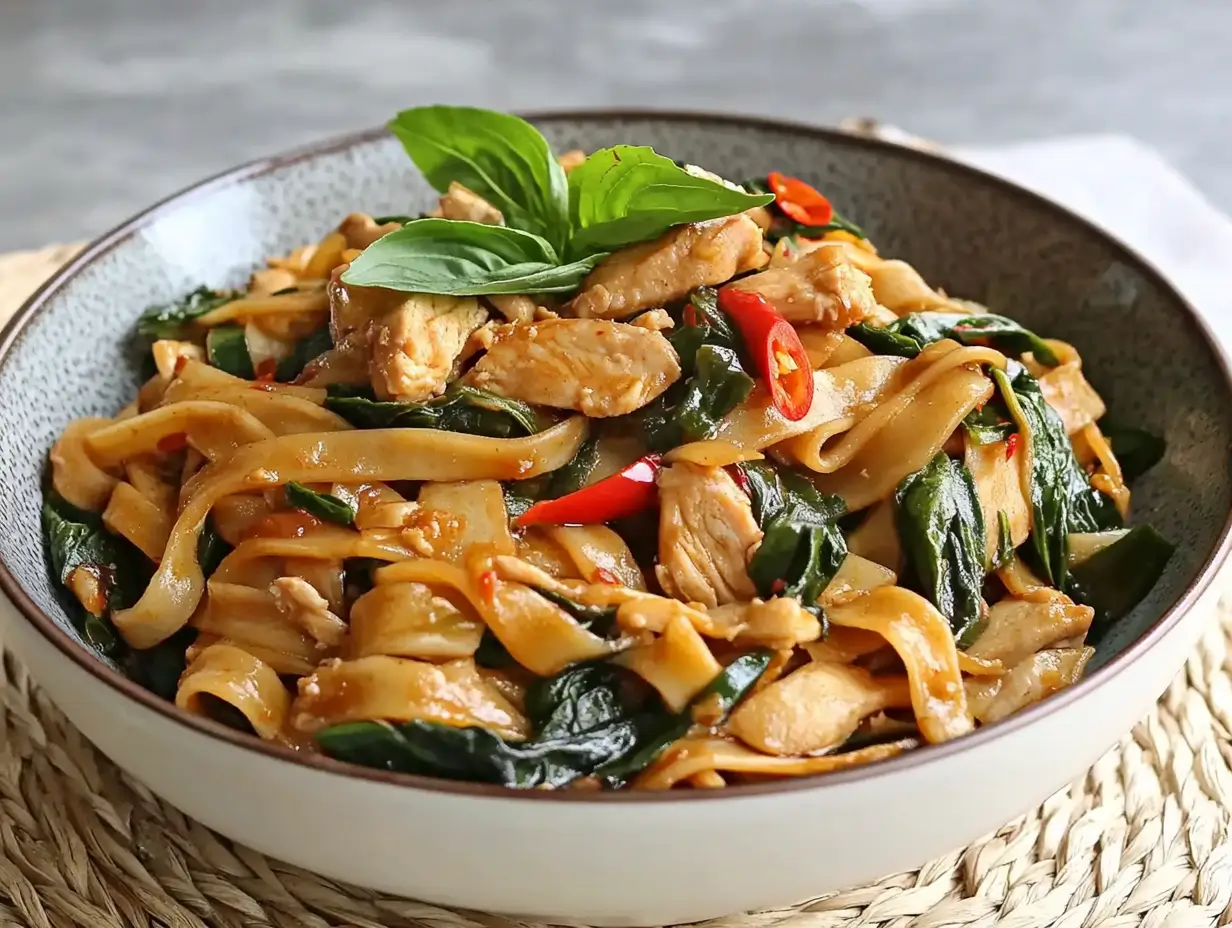Drunken noodles, or Pad Kee Mao, are spicy food that mainly steals the limelight from Thai cuisine. Such a spicy dish is a flavorful combination of textures and tastes, leaving food lovers wanting more. But then, why did it become such a global favorite? We will thoroughly explore the origin of this particular iconic dish, its unique flavor profile, and how to recreate it at home. It embarks on a colorful history into the contemporary appeal of drunken noodles, ending with an appreciation of their greatness.
The Origins of Drunken Noodles
What Are Drunken Noodles?
Stir-fried noodles in their basics would be drunken noodles-thai noodle dishes endowed with bold flavor. In Thai, Pad Kee Mao is wide rice noodles with vegetables and proteins such as chicken, shrimp, or tofu. The magic lies in a signature above-the-regional-type sauce that, with soy sauce and fish sauce, garlic, and chili peppers, creates an addictive spicy-sweet-salty-umami flavor.
While it’s tempting to compare it to its cousin dishes, Pad Thai and Pad See Ew, there are clear distinctions. Pad Thai leans on tamarind for a tangy twist, while Pad See Ew offers a sweeter, more subtle flavor. Nevertheless, drunken noodles are the one item that would spice up a life full of fire and dramatic stuff, such as Thai basil and bell peppers.
The History of Pad Kee Mao
This beloved dish hails from Central Thailand, where it has long been a street food staple. Its origins remain debated, but many agree it was born from culinary ingenuity. Some say the dish was created late at night by a cook improvising with whatever ingredients were on hand—perhaps after a drink or two. Others claim it was named for its perfect pairing with an ice-cold beer. Regardless of the story, one thing’s sure: drunken noodles have earned their place as a favorite in Thai kitchens.

The Unique Flavor Profile of Drunken Noodles
The Perfect Balance of Tastes
The dish best described as drunken noodles is its most balanced decadence. The unique mix of spicy, sweet, salty, and umami makes this dish very striking. It’s the fire from using fresh chili pepper while adding sugar or sweet soy sauce for sweetness, added with savory, salty undertones buoyed up with soy sauce and fish sauce-two essentials for Thai cuisine. A flavor dynamic layering sets it quite different from Pad Kee Mao. Garlic plus shallots base, then comes the Thai basil herbal fresh twist. So much deliciousness comes together within that mouthful, but never overwhelmingly so. The different bites have different taste snippets, which keep the taste buds engaged.
Versatility in Ingredients
Another factor that makes drunken noodles stand out is how adaptable they are. Wide rice noodles are the foundation, but beyond that, the possibilities are endless. The proteins have been chicken, beef, shrimp, and even tofu options, which the cooking can cater to different palates by including. Then there are colored vegetables—bell peppers, broccoli, and carrots—which lend themselves to the special texture.
Just as we can apply the same range in spices’ levels, you can have this absolute fire while someone could have it very mildly. This adaptability is a significant reason for its global popularity, answering why drunken noodles are so good for anyone who tries them.
This perfect balance of flavors is another reason drunken noodle is so good for food lovers everywhere.
Why Is It Called “Drunken Noodles”?
Popular Theories Behind the Name
If you’ve ever wondered, “Why are drunken noodles called that?” you’re not alone. Despite the name, there’s no alcohol in the recipe. There are plenty of legends surrounding the origin of this unique name. One of the famous ones is that it is the dish you enjoy having with a cold beer. It brings out the flavorful intensity of the dish wonderfully, meaning it is an ultimate midnight snack.
Another story claims that someone invented the dish during a drunken night. When a cook whipped up something with whatever ingredients were available, the chaotic mix of flavors might feel random, but the result is undeniably delicious. Some even speculate that wine might have been an ingredient in the original recipe.
The Literal Translation: Pad Kee Mao
The actual name of this dish, Pad Kee Mao, literally means “stir-fried drunkard.” In Thai culture, the even fierier and lively meanings of this term are that the dish is believed to be consumed by intoxicated people with such amazing ingredients—thick and spicy—that it is even believed to be a hangover cure. From whatever it came, though, drunken noodles have most deservedly gained that name.
These theories add to the mystery and excitement behind why Drunken Noodle is so good.
How Drunken Noodles Compare to Other Thai Dishes
Pad Kee Mao vs. Pad See Ew
When comparing Pad Kee Mao to Pad See Ew, it’s clear that each dish brings something unique. Introduce chili and Thai basil, and Pad Kee Mao is apparently fiery, bold flavors. Pad See Ew has this very mellow sweetness by dark soy sauce with the inclusion of Chinese broccoli.
Another important difference between these dishes is the variety of vegetables: whereas Pad See Ew incorporates mostly a few greens, drunken noodles can throw in some extra ignored vegetables such as bell peppers, onions, or zucchini. This makes the dish bright and also gives it that crunch. So these differences explain why a drunken noodle would be perfect for any spice-loving adventurous eater.
Pad Kee Mao vs. Pad Thai
In comparing Pad Kee Mao with Pad Thai, one must take note of their distinct flavor profiles. The tangy and somewhat sweet taste of Pad Thai from tamarind and crushed peanuts is in stark contrast to the hot and savory umami flavorings in Pad Kee Mao. Even the choice of noodles varies: Pad Thai uses thinner noodles, which give it a lighter texture, unlike the chewy, wide rice noodles of drunken noodles.
These comparisons highlight why drunken noodle is so good compared to its counterparts like Pad Thai or Pad See Ew.
For more Thai-inspired dishes, consider trying the Italian Drunken Noodles Recipe for a creative fusion of flavors.
How to Make Drunken Noodles at Home
Ingredients You Need
Making drunken noodles at home is easier than you think. Start with wide rice noodles, which give the dish its hearty base. For the sauce, mix soy sauce, fish sauce, oyster sauce, and a little of sugar for sweetness. The main elements are garlic, Thai chilies, and the distinct taste of Thai basil. Choose proteins such as chicken, beef, shrimp, or replace them with a plant-based source: tofu. Add chopped chunks of bell peppers, onions, and carrots to increase the crunch, flavor, and nutrient content.
Step-by-Step Cooking Process
- Prepare the Noodles
- Begin by soaking your rice noodles in warm water for 10-15 minutes until softened. This step prevents them from overcooking later.
- Make the Sauce
- Mix soy sauce, fish sauce, and sugar in a small bowl. Set it aside while you prep the other ingredients.
- Cook the Protein
- Heat a wok or large pan over medium-high heat. Add oil, then stir-fry garlic and chilies until fragrant. Toss in your chosen protein and cook until it’s tender and browned.
- Add Vegetables and Sauce
- Stir in the vegetables and pour the sauce mixture over everything. Let it simmer for a minute or two so the flavors meld.
- Combine with Noodles
- Finally, add the softened rice noodles and toss them with the sauce and vegetables. Please make sure you evenly coat the noodles and heat them through.
By following these steps, you’ll quickly understand why drunken noodles are so good—it’s not just about the flavors but also the ease of making it your own.

The Global Appeal of Drunken Noodles
Popularity Outside Thailand
So many people are in love with drunken noodles from all over the world today. Part of the attraction is in being able to cater to different palates. The traditional recipe is quite spicy, but chefs from various countries have tended to moderate the spiciness according to the local palates. This inherent suppleness is yet another reason that gives Drunken Noodle a good name-it is authentic but has been versatile.
Every Thai restaurant worldwide boasts Pad Kee Mao on its menu, and it is proudly touted as a bright alternative to something milder like Pad Thai. Tourists who visit Thailand become such excited fans of that dish that they go home with stories and inspire many to try making it.
Fusion and Modern Variations
Contemporary interpretations of drunken noodles may have made the dish even more trendy. For instance, Italian Drunken Noodles–the newest fusion of spicy Thai sauce with Italian pasta–is winning rave reviews. Such brilliant spins do not diminish the original but rather celebrate its versatility.
Even within these lively urban food scenes, one can find vegan and gluten-free versions of the dish. That is how drunks like drunk noodles, and this is how they have become the darling of food lovers around the world.
Its global appeal continues to grow, proving why drunken noodle is so good for people of all tastes.
For more fusion-inspired ideas, check out the Italian Drunken Noodles Recipe, a delightful twist on this Thai classic.
FAQs
Why Are Drunken Noodles So Spicy?
Can Drunken Noodles Be Made Vegan?
What Are Common Side Dishes for Drunken Noodles?
What makes drunken noodles so good? They are hot, spicy, and rich in flavor, and they can be served wonderfully as a perfect dish for just anyone.

